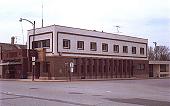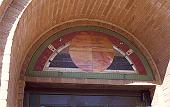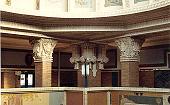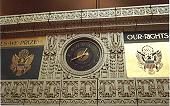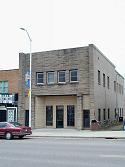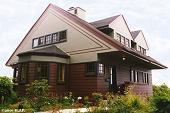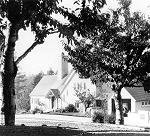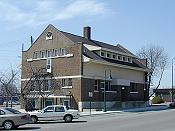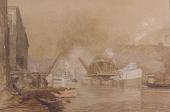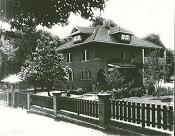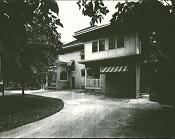|
|
|
Purcell and Elmslie, Architects Firm active :: 1907-1921
Minneapolis, Minnesota :: Chicago,
Illinois |
Ye Older Grindstones
6/16/2004
Farmers and Merchants State Bank
Hector, Minnesota 1916
Courtesy of John Panning
Mosaic
First State Bank
Leroy, Minnesota 1914
Courtesy of John Panning
Woodbury County Court House
William L. Steele, architect
Purcell and Elmslie, associated architects
Sioux City, Iowa 1915/1916
Courtesy of John Panning
Detail, clock
Woodbury County Court House
Courtesy of John PanningPicture Postcards. Punching through the web pages for the nice cluster of P&E images contributed by John Panning. He offers the first color photographs on this site of the Farmers and Merchants State Bank in Hector, Minnesota, some additional details for the First State Bank in Leroy, Minnesota, and some nice interior details from the Woodbury County Court House lobby in Sioux City, Iowa. The Woodbury page is getting a bit much for downloading, so that'll have to be restructured. I note, too, there are the occasional malformed fonts, etc., that call for attention; links have also been added to the terracotta and mosaics pages.
The whole exercise of this web site is to SHARE the great wealth of spiritual expression which characterizes the work of Purcell and Elmslie. So many times I have looked at the server logs and seen the far reach of these pages across some 100 countries, even North Korea! But it is especially satisfying to have companionship of a tangible sort, so I thank John and Howard for their contributions on behalf of all who travel in the Purcell-named "Caravan." And, better yet, there is more to come.
6/13/2004
Land Office Building for the Northwestern Lumber Company
Stanley, Wisconsin 1916
Courtesy of John Panning
Margaret Little residence
Purcell and Elmslie
Berkeley, California 1914
Courtesy of Howard Partridge
William Gray Purcell residence
aka "Georgian Place"
Portland, Oregon 1920Tempus Fugit. So, with a lapse of nearly two months, progress resumes--if uncertainly. Ironically, several generous users of this site have sent collections of images, and I have scanned nearly a hundred slides from my own files, but none of them have yet made their way to the server. A long-time colleague recently came to Los Angeles on business, however, and we celebrated my birthday by refreshing my enthusiasm for sitting long hours at the computer screen at home--not as opposed to but in conjunction with doing the same thing at work all day. Something is going to have to be done soon about the antiquity of the computers supporting this site. The ancient Pentium I 100 that serves the pages themselves is now overloaded with the firewall and other software necessary to hang out in the badlands that is the Internet. And my workstation, a seven year old Pentium II 350, is almost incapable of handling the size of the site.
I've thought about transferring the site to a web host, and giving up the expensive (read: nearly unaffordable monthly) DSL business package that makes all this possible, but Organica has several separate sections. Some of these rely on my HyperFind software, whose components might not be (probably aren't) mountable at a web host. And there is the problem of the file names used in FrontPage being incompatible with Linux or other server software. I can't see renaming potentially 3,000 pages to comply. So, things have been stuck on some levels other than just my hands.
Talking with my visiting friend over good wine made clear to me that I really do want to work on this, and bring the whole to a conclusion that has yet to be fulfilled. I've published more than seventy-five articles, five goodly essays (translated into French, Italian, Turkish, and Japanese), and the monograph in the Minnesota 1900 book. Yet, even after twenty-five years, there remains something beyond that wants to be done. I am clear about what that is, strangely enough. The question--as always--is how to find the space/time that curves into the workplace. Where are the good angels that used to make grants?
To rub the sticks together and rekindle the flame here, I have added a link to a web site at the San Francisco Museum, which offers a letter from the Edison Photograph Distributing Co. announcing closure of the Edison Shop on Geary Street in 1927 (I told you this started out ironically). John Panning gifts us with three images of the Land Office Building for the Northwestern Lumber Company, whose mortal remains are located in Stanley, Wisconsin. One could hardly find a more inappropriate series of skin grafts, ersatz "stonework" whose "lines" are wholly disconnected from the basic symmetry of the building and a latter-day application of cream brick that only produces a further alien effect. Howard Partridge, who maintains the wide-ranging architectural site Cupola.com where Organica is linked with generous praise, sends a image of the Margaret Little residence in Berkeley, California. Finally, in the How Could It Happen Department, I have added an archival image of the William Gray Purcell residence, also known as "Georgian Place," in Portland, Oregon, whose previous omission from these pages borders on the incomprehensible.
4/18/2004
Municipal Building
Kasson, Minnesota 1916
(But for how much longer?)
Courtesy of John Panning
Municipal Building
Sawed wood detail
Courtesy of John Panning
Knowlton residence
Rochester, MN 1911
Demolished
Courtesy of John Panning
Knowlton residence
Rochester, MN 1911
Courtesy of John Panning
Coming, Going, Gone. One of the nicest aspects of being drawn to the same thing is discovery of other human beings who share your interests. From time to time the descendant of a P&E client (or, most recently, the granddaughter of William Gray Purcell) will send an email. One Organica correspondent has kindly sent along some newly taken images of the Municipal Building still standing, or perhaps lingering, in Kasson, Minnesota. Reported to be now emptied of a former water treatment company tenant, we can all wonder how long it will take for Minnesota winters, deterred maintenance, and potential vandalism to degrade the remaining structure into eventual ruin. Our kind supplier of these images perceptively notes:
"...It is an odd building. Somehow the need to accommodate the several disparate functions didn't call forth the sort of synthesis achieved in Rhinelander and elsewhere. The building is largely ornament-free, save for the fret-sawn wood about the front door and in the hexagonal gable openings; the original (and peculiar) "chimney pot" is long gone. No budget for ornament didn't prevent P&E from achieving greatness, of course: the nearby bank in Le Roy is proof-positive of that..."
All true, with the caveat that this building post-dates Rhinelander and Leroy by five years, and the world was mightily steaming toward global cataclysm. By that time, the only reason this building got built at all was that it served as a public community building, particularly the post office. The war had already moved Purcell away to Philadelphia, and the drawing production and construction of this building was overseen by Fred A. Strauel and Fred M. Hegg, respectively. The light standards that used to stand in front have apparently disappeared, and although there were some small slivers of leaded glass in upper story side-lights, these are now perhaps missing.
Alas, even ruins are no longer left of the E. E. Knowlton residence (Rochester, Minnesota 1911), only two window grilles, remade into coffee tables (though I confess this is an oral story and I never actually saw the things themselves). The Knowlton house is essentially a country dowager, with traditional windows. We can read from the form that the client was undoubtedly conservative--or at any rate the client wished to be accepted by the neighbors as such (Purcell called him "a bombastic raucous rube)"--in the traditional way of southern Minnesota, even in town like Rochester whose professional population of doctors and engineers has always required more culture than the nearby countryside. The square, wholly box-like form bears some kinship with the Lyman E. Wakefield residence (Minneapolis, Minnesota 1911), which was designed and built at the same time. Thanks again to our good friend for this happy contribution. "The more, the better."

